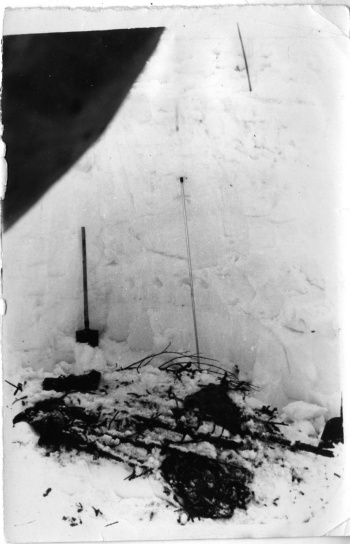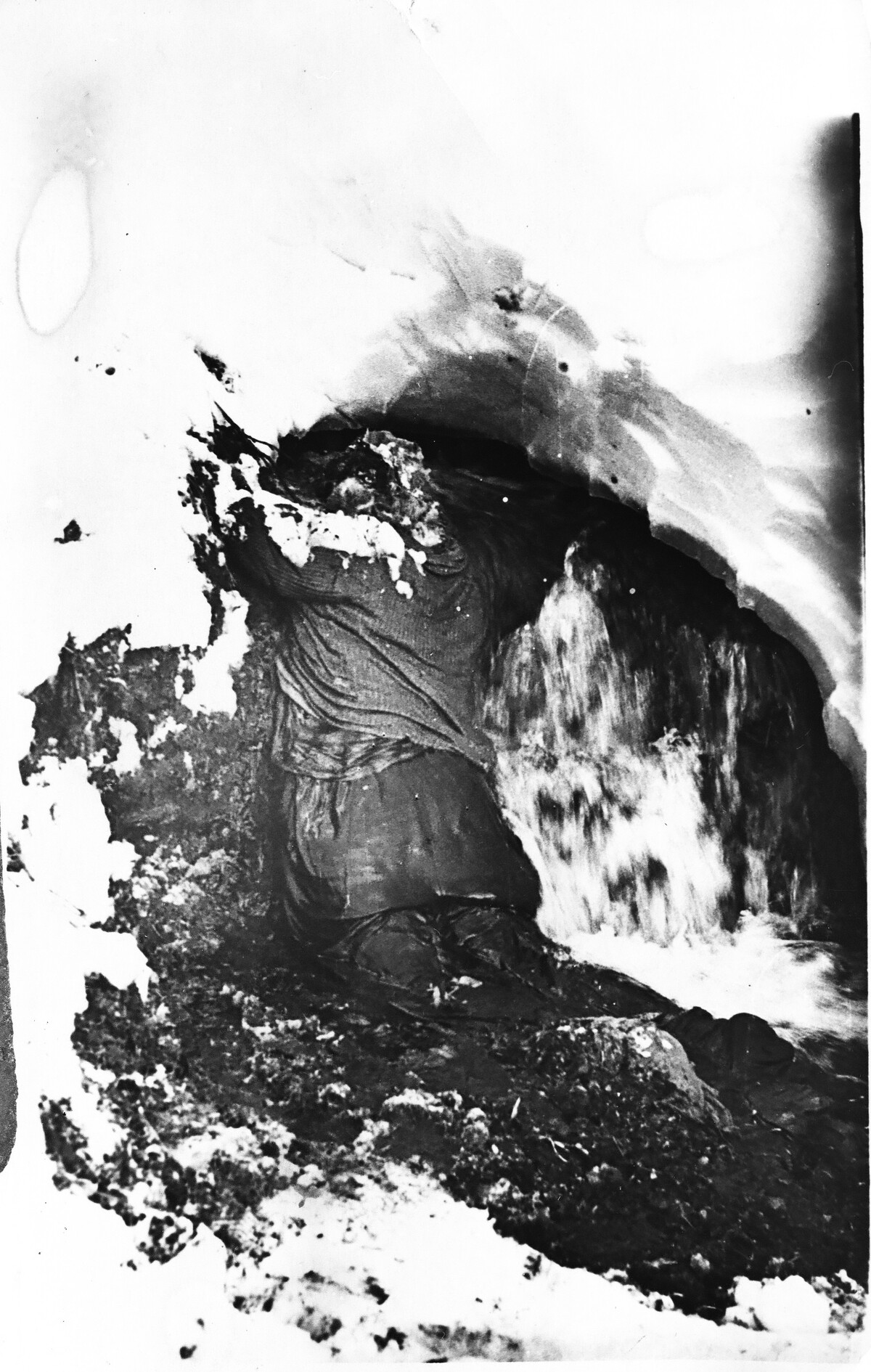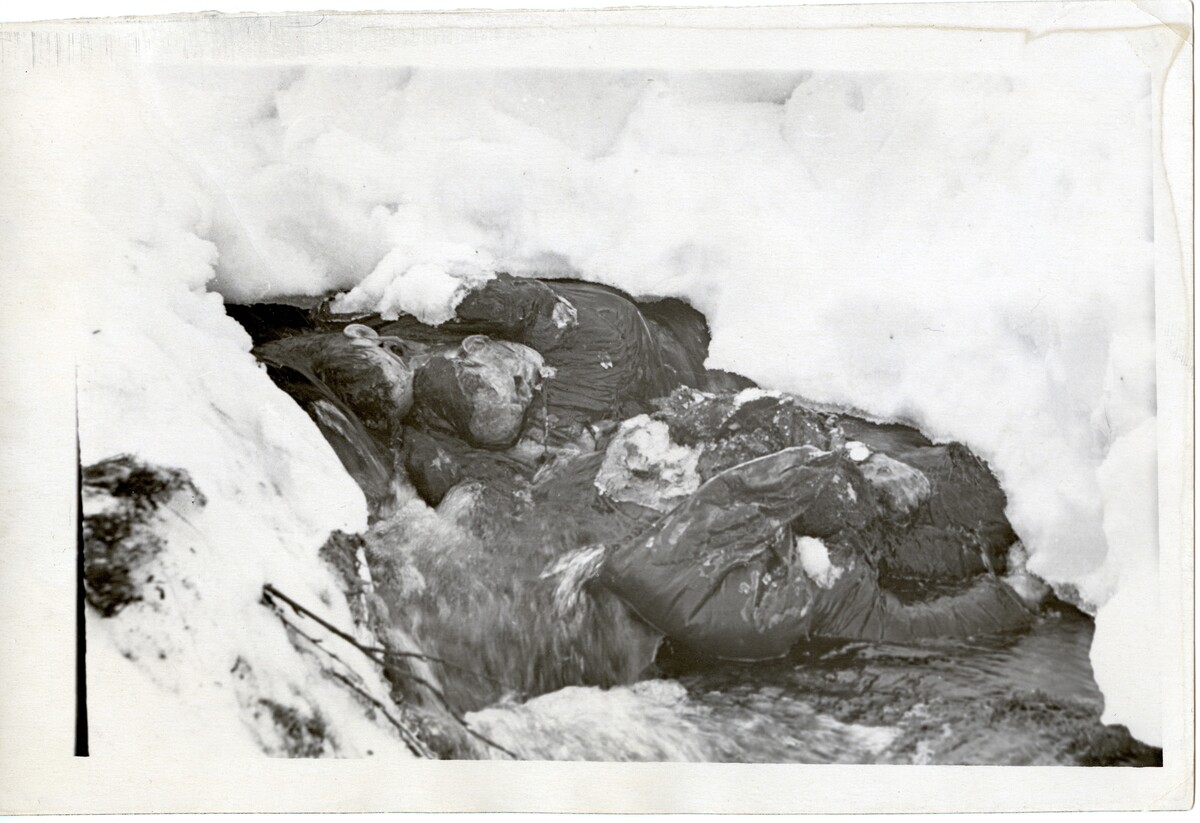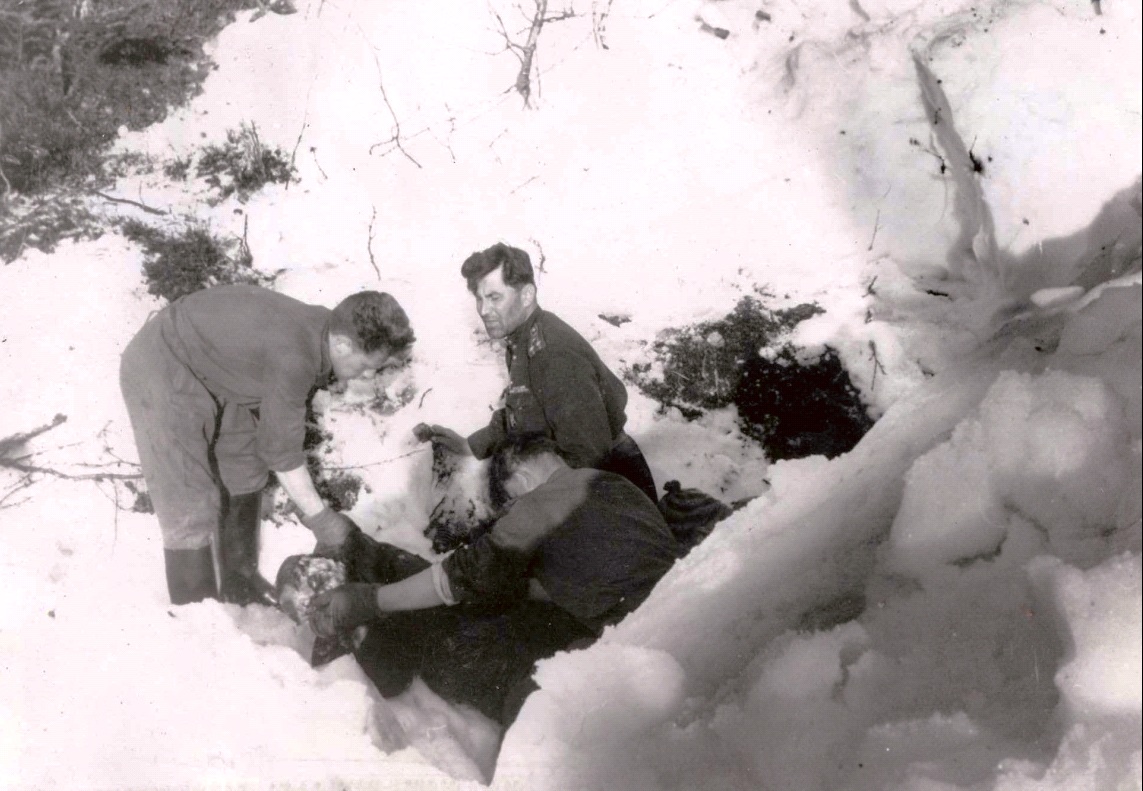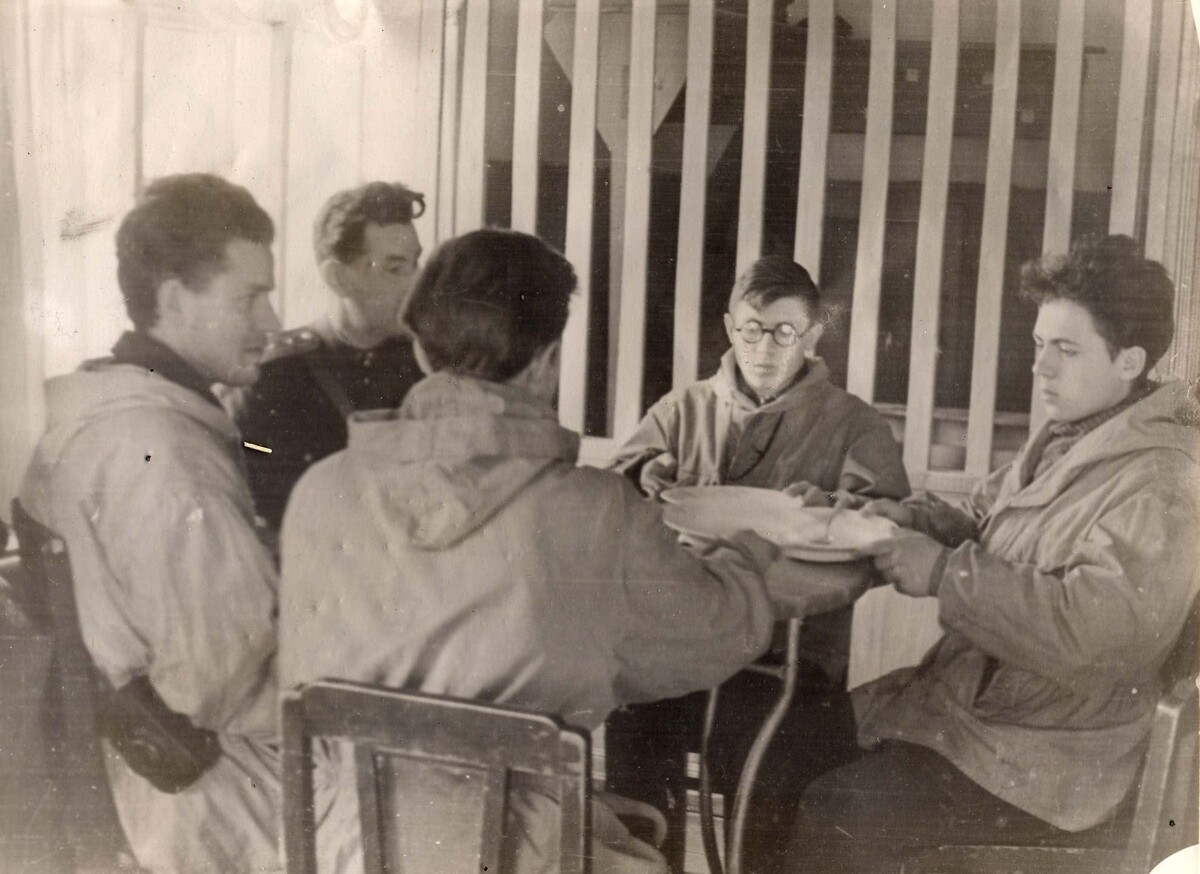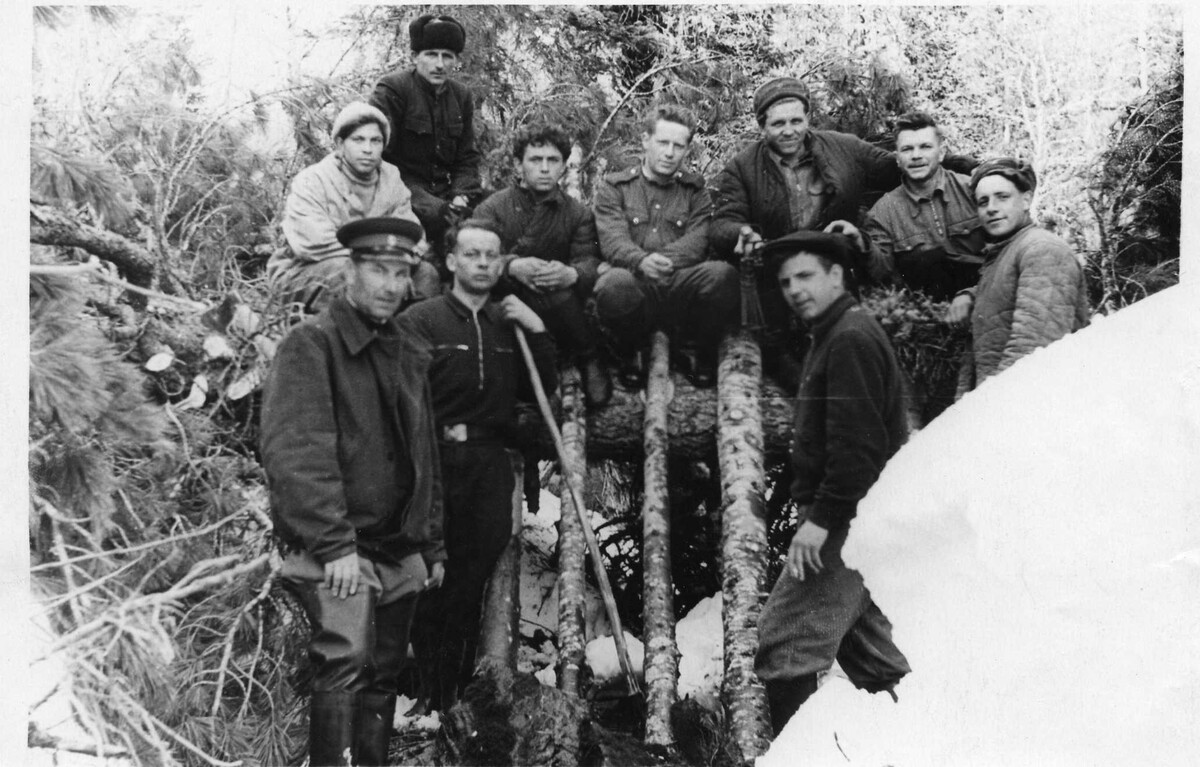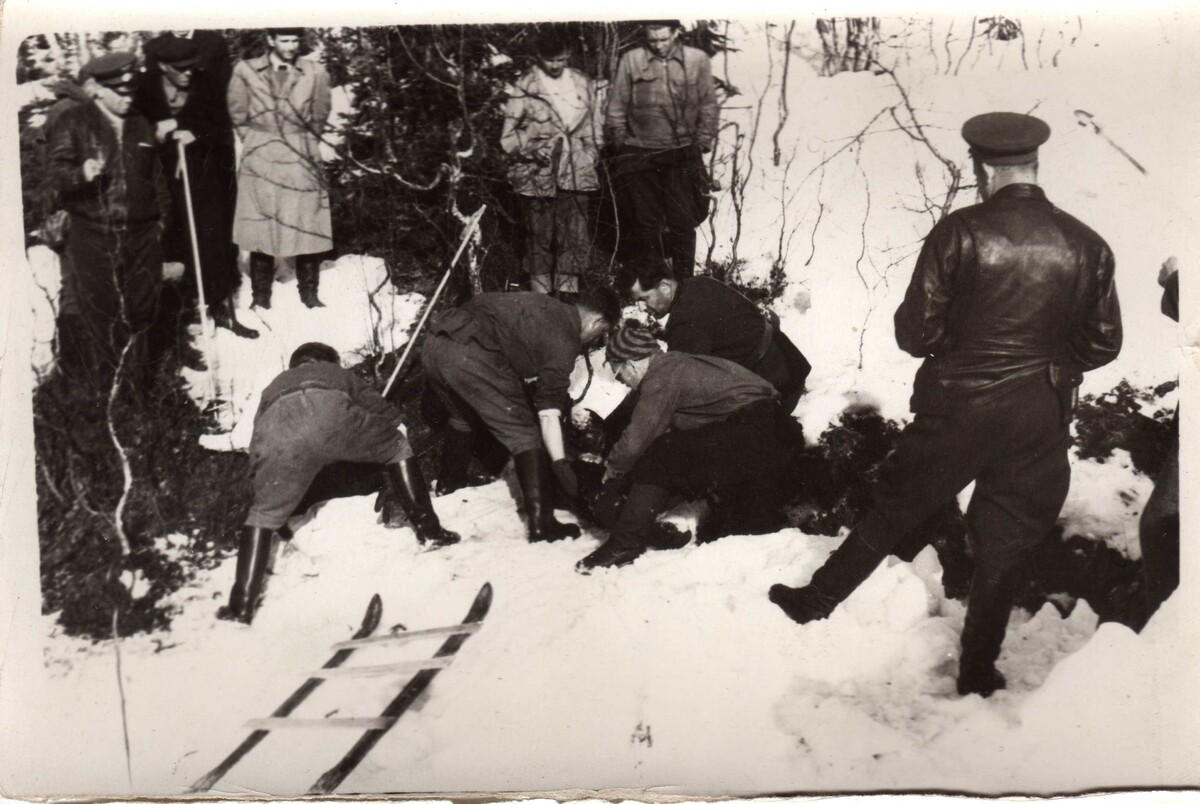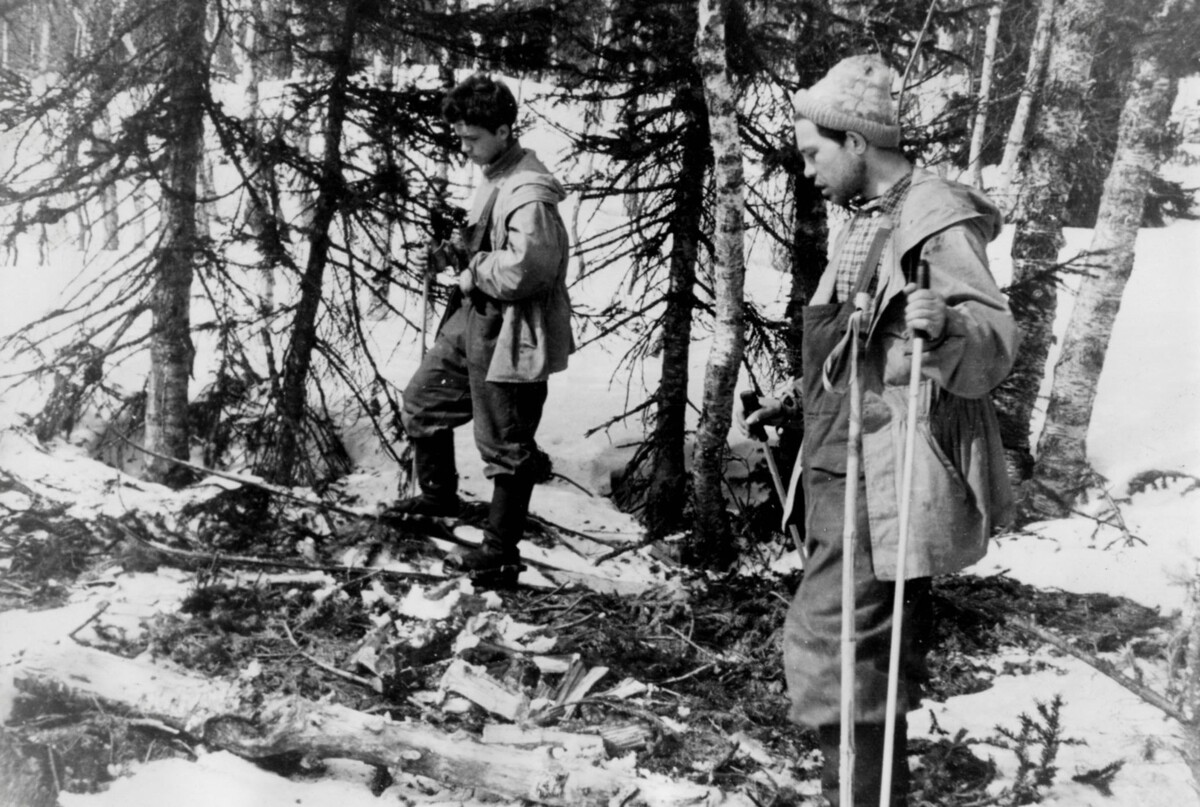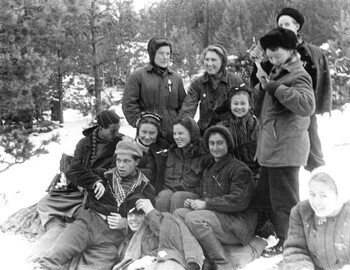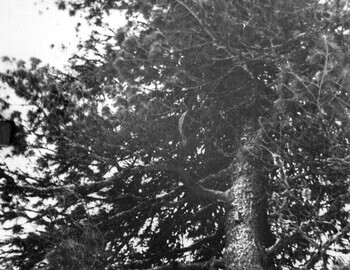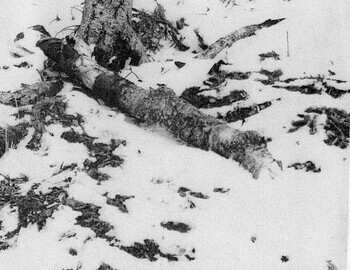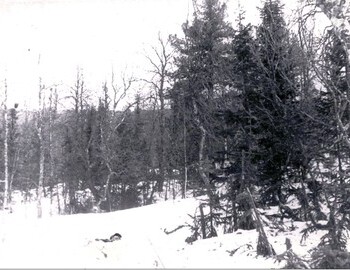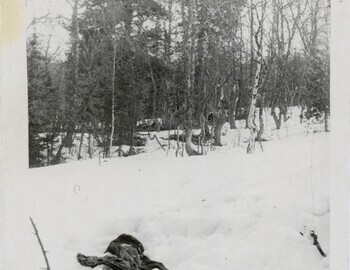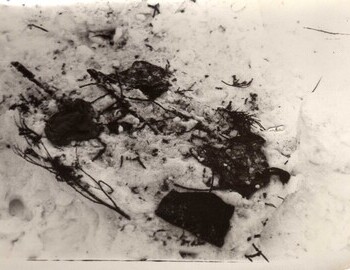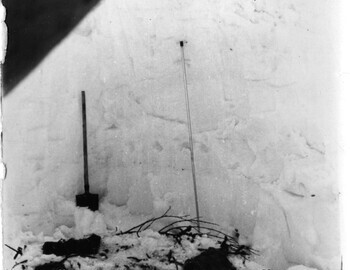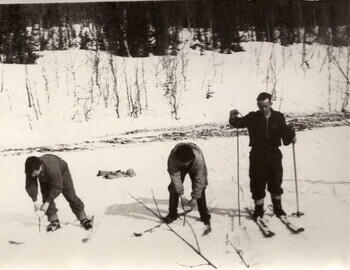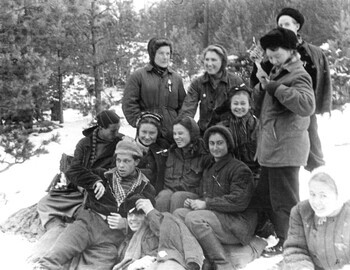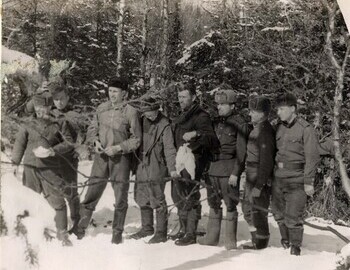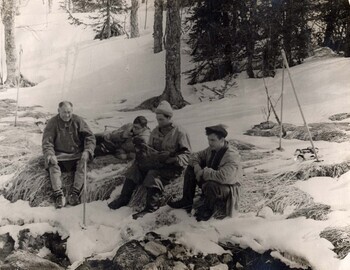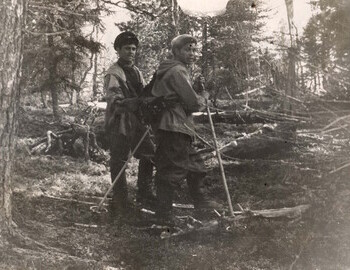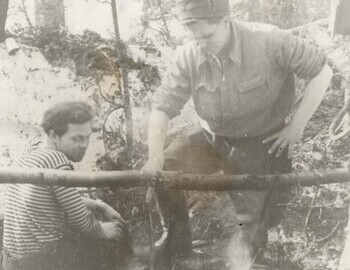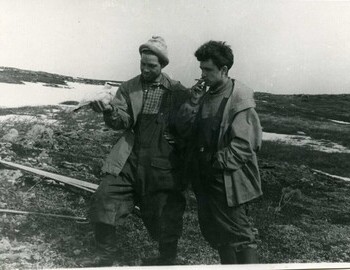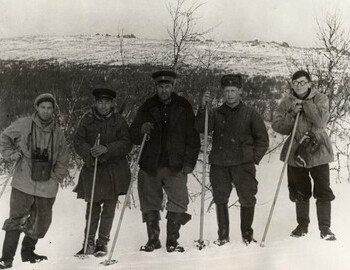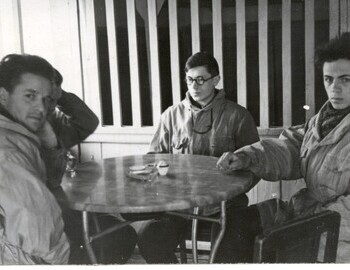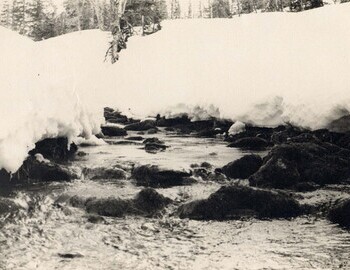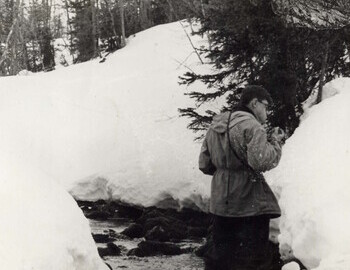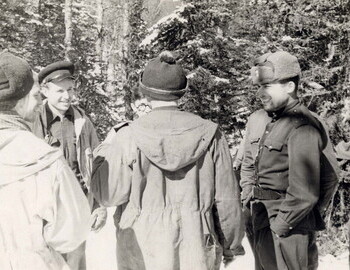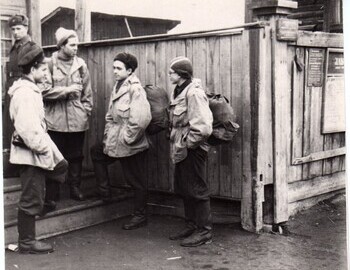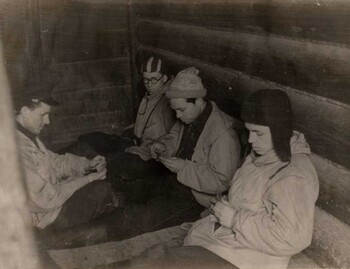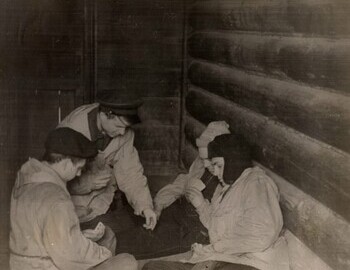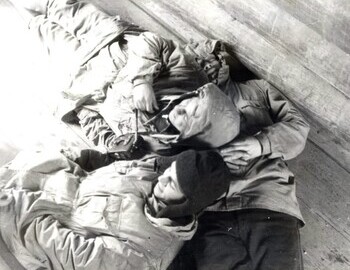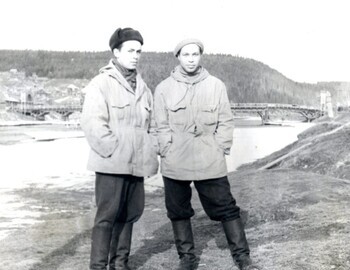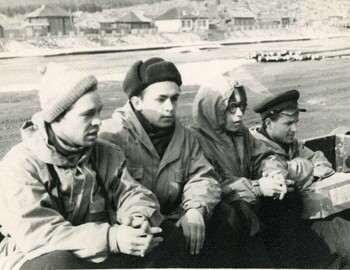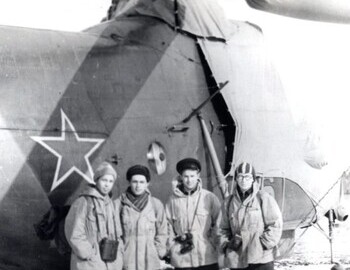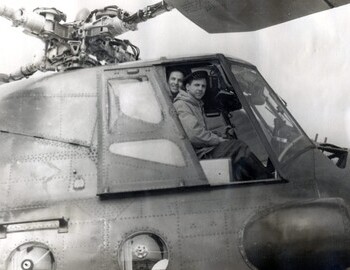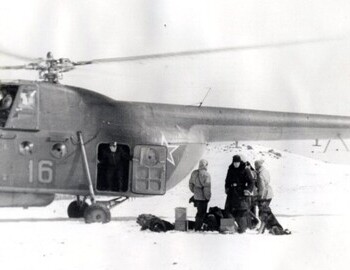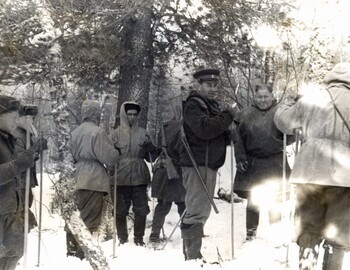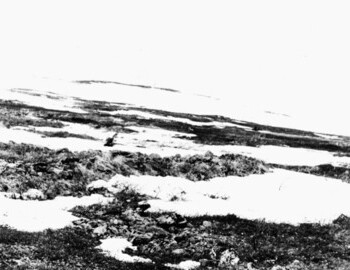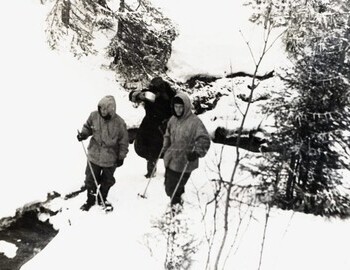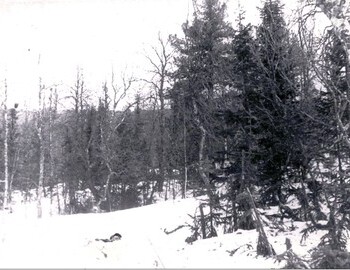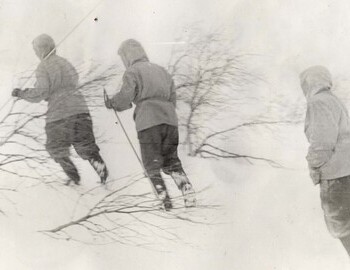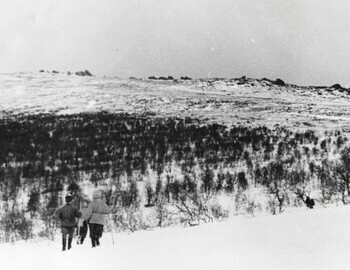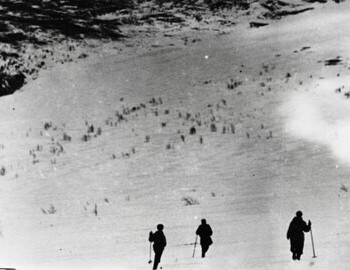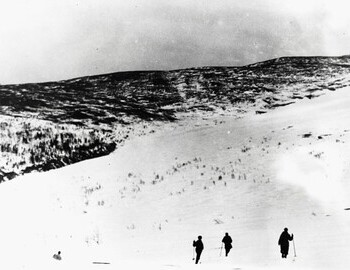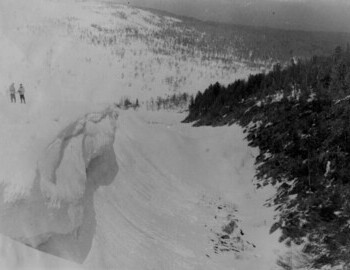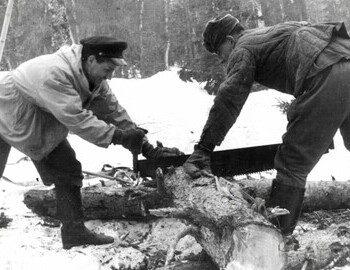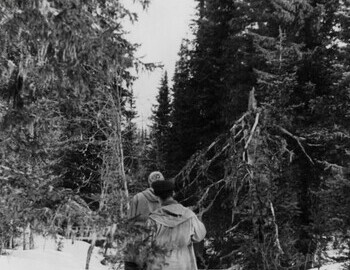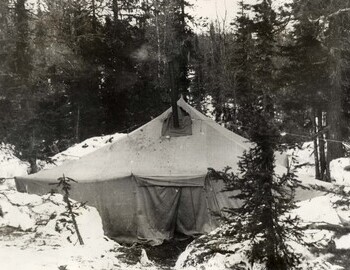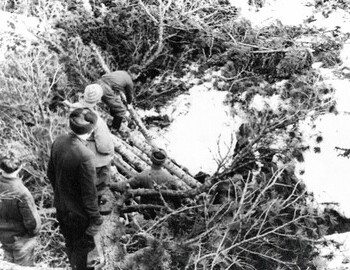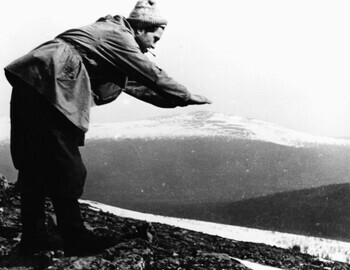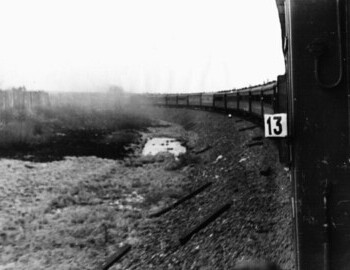
Vladimir Askinadzi interview 2012
Head of the UPI search party Apr 25 - May 8
Maya Piskareva. September 2012
It wasn’t me who found Vladimir Askinadzi. Videlson found him.
I didn’t suspect his existence at all, I only caught a glimpse of Askenadze's surname when I was studying the materials of the Criminal Case on the death of the Dyatlov group; his signature is in the Tempalov protocol of the location where the last four bodies were found in May 1959. The surname Askenadze was also found in some of the memoirs of searchers, students of those years. That's all. Well, as a member of the search party, like many others, he can add something special to the stories of others, when his UPI comrades basically all say "I don’t remember, I don't know, I forgot"...
And when Videlson sent me the address and asked if I wanted to talk with Vladimir Askenadze, I was not very enthuse. I’m tired of getting information about that tragedy, and in response, instead of simple gratitude for new information, I mainly receive pokes and slaps from other "researchers". It's summer, we're packing our bags, we're going to our homeland, Russia, St. Petersburg! What interview, leave me alone, I'm on vacation.
But my soul was uneasy. How is it possible... I have the address of the person who found Lyuda Dubinina, and I don’t take advantage of reaching out to him?
Of course, upon arrival in St. Petersburg, I immediately wrote a letter and I received an answer.
Meeting Vladimir Askinadzi greatly changed my life. I am still impressed by my interactions with this man. I’m probably even in love with him, but I don’t want to admit it to myself.
Bottom line is Vladimir Mihaylovich Askinadzi told such incredible things about the search and people, one way or another connected with that distant tragedy, that I personally was shocked. And I think that many will also be stunned by his stories, so easily he destroyed many of the myths of the Dyatlov case research. And he is a wonderful storyteller, so I didn’t even interrupt his story with any questions, but decided to leave everything as it was, the live speech of Vladimir Askinadzi himself. Read and discover for yourself the truth the way I did with each letter I received from Vladimir Askinadzi.
I am grateful to God that He "at the fragile crossroads of the universe" brought me together with such an interesting, such a wonderful person as Vladimir Mihaylovich Askinadzi.
* * *
Abbreviations in the text:
ВМА - Vladimir Mihaylovich Askinadzi
МП - Maya Piskareva
* * *
MP: Tell me, please, are you the same Vladimir Askenadze, a student at the Ural Polytechnic Institute who took part in the search for the missing Dyatlov group in May 1959?
VMA: Yes, Maya Leonidovna, I am the same Vladimir Askinadzi who participated in the search for the last four from the Dyatlov group in May 1959. I am at your service. I just ask you to take into account that 53 years have passed since then, and many details, naturally, have been erased from my memory. Therefore, do not blame me if I am of less use than you expect. I'm waiting for your questions.
MP: Dear Vladimir Mihaylovich! Thank you for your response, thank you for agreeing to answer my questions! I'm so glad, you can't even imagine how. It doesn’t matter that 53 years have passed, because the main thing still remains in you memory. I really don’t know where to start, I’m bursting with joy that we found you. Don't judge strictly, please! But it seems to me that only you can answer questions that no one has answered. Perhaps I’ll start with something simple: please tell me how to spell your last name correctly?
VMA: My last name is correctly spelled with an "i" at the end (if that makes any difference).
MP: Do you follow the topic of the tragedy in the press or not? Do you communicate with any of your former classmates at UPI, or with someone with whom you were on the search?
VMA: Yes, sure. I have fairly close contact with my fellow hikers in Yekaterinburg. They regularly send out all the new publications that appear on this topic, including the Ural Pathfinder magazine. I also read things from the Internet. By the way, about the press. A lot has appeared and, probably, outright absurdities in explaining the causes of death will continue to appear. I believe that the food for this was provided by a very unscrupulous forensic expert, who stated that the wounds of Lyuda Dubinina, in particular, were pre-mortem. Blatant nonsense. She lay on a small ledge, and melt water flooded her face. She lay in this position for more than a month and a half. Naturally, all soft tissues and even her tongue were washed away (her mouth was open). When I wrote to the guys in Sverdlovsk that the examination was unfair, they told me that this version was "unexpectedly new". Obvious, and suddenly new. Apparently, the authority of the government body was quite great.
I know that Nikolay Kuznetsov worked at the Novovoronezh nuclear power plant. I don’t know anything about the other members of my group, but this is probably the fault of the conditions in which I found myself after graduating from the institute. Very good long-term communication with Evgeniy Zinovyev and the Poluyanovs. Through them, I know that the tradition of gathering on the first Saturday of February is still alive!
- 2 -
MP: Do you remember how you found Lyuda Dubinina? Who identified her, who said that it was her?
VMA: Not only do I remember, but it was I who found it. Everything happened both planned and by chance, as always. We localized the search area to several square meters and, working with emergency probes 2 meters long, I hit Lyuda in the neck. I thought it was just moss. But when I turned the probe and pulled it out, there was meat on the hook (Can you imagine how an emergency probe works?). This caused a real commotion, and the head of the search, Colonel Ortyukov, was especially worried. It was May 4th.
No one doubted that it was Lyuda, since we were looking for her.
MP: Did you know Lyuda from UPI? Have you talked to her? Please tell us everything you remember about her.
VMA: I didn't know Lyuda. You can ask Evgeniy Zinovyev or Pyotr Bartolomey, they knew all the hikers well.
MP: Vladimir Mihaylovich, this question may seem strange to you, but I have to ask it: when you found the last four in the ravine, were there four bodies there, or more? In one of the photos in the ravine you can see how the military are pulling out the body of some unfamiliar girl with a dark long braid. She doesn't look like Lyuda.
VMA: There were four of them.
I’m writing these lines, and I’m back there again, as if these 53 years never happened!! Again everything is clear before my eyes. The emotions of those days are especially clear.
After all, how did we find them??
In an interview with Vladimir Androsov, you asked him a question about the den and he, without looking it first hand, said, "No one cut these trunks, because they are dry without needles, look carefully, they were simply collected. There are such fallen trees in the forest. They could break them with their hands. Yes, there is some kind of dry wood there, old dead wood."
If they had dry dead wood, they would be alive. There was nothing to make a fire from, so they climbed the cedar tree to get at least a little dry material (they believed that the lower branches of the trees were drier than the upper ones). They cut off the tops of young fir trees with a knife to make a den, lay it in a low place and shelter from the wind.
When these tops were dragged, small branches broke off, and there was a barely noticeable path from these branch tips. Using THEM we found the den. On the morning of May 4 (Ortyukov gave us a rest on May 1 and 2, since we had been very tired in recent days working with the probes), so, on the morning of May 4, the Kurikov brothers were discussing something in my presence in their own language, but from their gestures one could guess that we are talking about these branches. We went to Ortyukov’s tent. Stepan Kurikov was in charge, he explained to Ortyukov that we needed to dig in the area of the branches, although the day before it was decided that we would dig in the stream, but much higher than the headless fir trees. This is where our success began!!! The branches led us deep into the snowdrift, almost vertically. You probably have a photo where I placed a 2-meter probe to scale the depth of the crust. Another meter remained to the top level of snow. The den lay at a depth of about 3 meters, and all the branches of the fir trees were freshly cut!
Here is a photo of the den and probe for scaling. The upper dark corner is the edge of the tarpaulin covering the bodies from the sun before the arrival of the authorities.
MP: Thanks for the note about the den. Mikhail Sharavin, by the way, said that the needles in the den were reddish, according to Ivanov. That's what's interesting. Do you remember the branches in the den being green and fresh?
VMA: In my opinion, Ivanov didn't even approach the den. From afar he looked at the fir trees without tops and went to the bodies. By the way, I noticed that Ivanov did not write down anything, did not photograph anything. It seems that he is not interested in the discoveries, as if he knew in advance the cause of death and what we will find next. And then - this area was closed to hikers for many years. I will express my opinion without imposing it on anyone. This area is not interesting for treks. It’s only good at one thing - you can do it during the winter student holidays, and that’s the beauty of it. Well, I responsibly declare that the den was made from live tree tops!!
MP: Thank you! Then what happened?
- 3 -
VMA: Now it became clear that there was no point in moving far from the den. We need to look in the next 10-15 square meters. Another personal observation of mine: they cut off the tops of the trees and made the den after the guys froze under the cedar tree, since there were their things on the floor of the den, including trousers cut at the crotch. This way you cut clothes only from corpses. These events took place before lunch, and after that I alone took the probe, and the others watched, not because they didn’t want to work, but they agreed so, just to do a test pit, as in geology. That’s when I hit Lyuda's neck. If my probe had deviated 10 cm to the right or left, we would have gone up the stream to probe the snow. This is both an accident and a pattern at the same time. Of course, we would still have found them, but maybe a week or two later. And if you consider that it’s May, the test session has begun at the institute and exams are coming soon, and I’m in my 5th year, then there’s no need to explain what the additional weeks of being away from the institute mean for us.
The whole camp, even the lazy "dog trainer" who slept for everyone (we were joking that "we are going on a search, and you sleep today for Suvorov, and tomorrow for Mohov") and he also came running. It was around 2-3 pm. The day there at that time was quite long.
We began to dig carefully, and another head appeared 20-30 cm from Lyuda's head. But in order to dig further, it was necessary to remove Lyuda's body. We took her out and laid aside, wrapping her in some rags. This is why you cannot identify her in the photo. Her corpse simply wasn't there anymore. In the scene the next day, in the presence of all the authorities, we pulled out only the guys.
This is Lyuda's body. She is kneeling and her head is resting on both hands. Water rolls over her head. This is what we saw. Legs in random wraps, sweatpants, a checked shirt and a light sweater. Pay attention to the ledge on which Lyuda's head lies. It will be seen in the next photo, but without Lyuda.
At the bottom of the frame is the ledge on which Dubinina’s head lay. Zolotaryov has two watches on his wrist. Well, look at how far their heads are from each other?? On one square meter, if not less. Kolevatov and Thibeaux-Brignolle's eyes were washed and their scalps were almost removed. See for yourself! We saw the same thing. The difference is small - we saw this in a state of extreme tension and nervousness. Not only that, we only saw them for a very short time. They pulled them out of the stream, wrapped them in sleeping bag liners and special bags that the pilots had brought, quickly signed a document, and the corpses flew away. You can calmly look at the photo even through a magnifying glass, calmly, for weeks. Then came the questions. For many years there were questions, questions and questions. For the most part, someone invented something absurd, and then asked to confirm whether, for example, there were burnt tree branches, suggesting a small atomic explosion or a rocket crash. I know only one thing - to scare an adult man to death or cause him to panic, bordering on loss of reason, you have to try very hard. Monka Akselrod put forward the idea of an avalanche. I immediately told him, could an avalanche scare you so much? He remained silent, but continued to insist on this version in the press. There were even enthusiasts, I think from St. Petersburg, who conducted a whole large-scale scientific experiment, proving that a terrible avalanche could come down from a slope of 17 degrees, throwing hardened young guys into panic. An avalanche on such a slope, in the worst case, if it starts, it will end in a couple of minutes, well, even in 5 minutes. It won't have any more energy. You can't be scared by this! In the end, they concluded that an avalanche was possible, but not catastrophic. What a joke!! You can tell this by reading popular literature on avalanches, and determine the angle of the slope from a photo. And that's it!! But...I don’t invent hypotheses.
- 4 -
Kolevatov is the last one being pulled out. No eyes, no hair. It’s impossible to grab him by the body - it’s falling apart... only by the clothes. The eyebrows, as far as I remember, were not preserved. Yes, this can be seen in the picture - there is nothing above the eye sockets.
As for some kind of freezing of the corpses, (how do people know such clever words??) I don’t know. I know that we put them in bags slowly, without breaking them. Their joints were mobile.
MP: There is some misunderstanding. According to the autopsy reports the two watches were on Thibeaux-Brignolle's hand, and Zolotaryov had a compass on his left hand.
According to the autopsy report, Thibeaux-Brignolle has: "On his left forearm there are two watches: a sports watch that shows 8 hours 14 minutes 24 seconds. The Pobeda watch shows the time 8 hours 39 minutes."
Zolotaryov and Lyuda had no eyes at all, while Thibeaux-Brignolle and Kolevatov had eyes, but they were wrinkled and sunk deep into their sockets. Kolya’s eyes were generally closed with eyelids.
Therefore, the question remains - who was next to Lyuda in the stream. Isn't this Kolya? From the photo you can clearly see the watch on his hand.
VMA: The heads of all the guys lay on one square meter. That’s the only reason we pulled Lyuda out in the evening, because she was preventing us from getting to the others, and left the rest until the forensic experts arrived - that’s what Ortyukov wanted, and he was right. Only the criminologists themselves did not need this. Have you seen the photo where they are all standing, like spectators at a play.
Lyuda and Zolotaryov lay facing the stream, and water filled their mouths. And the other two lay along the stream - their hair was washed away from their skulls and that’s all. One had a storm jacket hood on his head, the others had nothing. Lyuda also had nothing on her head.
When we took out the bodies of the guys, Zolotaryov had a notebook in one hand and a pencil in the other. Ortyukov rushed towards him like a madman, and then suddenly sank, not finding anything written down, saying, "I didn’t write anything, you slobber." Dear Colonel, if you can hear me in the next world, what would you write if you spent at least 6 hours in 30-degree below zero... Why Zolotaryov held a notebook and a pencil in his hands and did not write anything down, one can only guess. There was probably no time for that, and his hands were already frostbitten to the elbows.
I'm not a forensic expert, I'm just a living witness of the first minutes. I have the right to object to those who, either from someone else’s words, or simply made a gag, embellishing the facts to make it more convincing, I saw everything myself!!
MP: Vladimir Mihaylovich, did Zolotaryov have a camera? Were there any cameras in the creek?
VMA: I don’t know about cameras. It seems to me that they were no cameras at all, otherwise the hope of getting photos would have raised interest. If the discovery of the notebook in Zolotaryov’s hand caused a stir, then the camera would have exploded the situation all the more.
MP: And the tongue... When did you find out that Lyuda's tongue is missing? That Lyuda and Semyon have extensive rib fractures and no eyes...
VMA: I learned that Lyuda did not have a tongue when I arrived in Sverdlovsk. Already in Svedlovsk, I learned that the children would be buried in closed zinc coffins, but Lyuda's father insisted that they show him their daughter. When he saw her, he fainted. Would you like us (also living people) to calmly look into the mouth of a corpse! For this there were other specialists, professionals. At that time we were also standing on our nerves.
And now my version of their fractures. I already mentioned above that they lay under a 3-meter layer of snow, and not just snow, but wet snow. There is rock bed under the ribs, 3-4 tons of snow on top (static and systematic load) for at least 2 months. What do you think can be expected under these conditions?
After all, no one has ever imagined themselves in their place!! I tried to construct events, but I did not have enough information at the time. I’m passing this relay to you, I don’t have enough time.
MP: What about outsiders? After all, Thibeaux-Brignolle and Slobodin seem to have been hit hard on the head.
VMA: No one hit them on the head. No-one!! If someone were an outsider who allegedly hit humble 20-year-old strong guys on the head, then he (or they) should have hit not just one, but everyone. This means there should be as many of these hitters as there were guys (7 people), or there were no one and you should look somewhere else. Look for it!!! All of you who are involved in this research have your whole life ahead of you, and we’ve already had our fill of it. There was everything around, but not the truth and not the desire to help. One got the impression that the authorities did not need the true cause of death. Well, some group of students died, were they the only ones in the Union? Who knows that Marshal Zhukov, future Minister of Defense, detonated an atomic bomb over his own soldiers without a warning. How many "hiking groups" does this make who perish without groaning?? And they were 18-20 years old, younger than the Dyatlov group.
The truth is needed when it helps to avoid repetition, when every person counts and must be taught how to behave in such a situation. The authorities did not have such a task. The main task is to extend your power at any cost.
For the last time I ask you, if you want, I beg you, throw the option with murderers out of your head. It will lead you to a dead end. You'll only waste time. There was no one there except the Dyatlov group. Of course, if the authorities were serious about a real investigation, the first helicopter that landed the first search group should have photographed all the traces and the entire situation from above. After all, from above you can see a lot that has not yet been trampled. But... Newton, when asked what the nature of gravitational forces is, answered: "I don’t invent hypotheses."
I once read an article by an enthusiast, I think, Yuri Kuntsevich. He saw the reason for the death of the boys in the machinations of the special services. According to his version, the guys were killed because they became accidental witnesses of some terrible secret. And in order to cover their tracks in front of the public, they were loaded onto a helicopter and dropped to the ground from a great height. Hence the pre-mortem wounds, hence the position of the bodies, as if along a pre-marked straight line!! This cannot even be called stupidity, it is pathology. At that time, the authorities did not care about public opinion; they had no one to hide from.
The riddle - the answer to who lies where - you will never solve, and not only you, no one at all.
I will explain in detail and clearly.
My students - fellow searchers - never saw the Dyatlov group alive. I only knew Zina well; I didn’t know the rest of the guys. True, in one of the photographs, Igor Dyatlov seems to be standing in the background in an out-of-focus area. If this is so, then we can say that we stood next to each other, 5 meters from each other, and no more. When we left on our search, we knew only by last name who we had to (!!) find. You see, there were no problems with Dubinina. When talking about guys, their last names should be put in quotation marks, "allegedly Kolevatov", "allegedly Zolotaryov", "allegedly Thibeaux-Brignolle". Now you don’t need to explain the quality of Ivanov’s work. We retrieved the corpses, and others identified them, who understood this even less than us. I wrote to you in one of my letters about my attitude towards the quality of Ivanov’s work, that he was more confusing than investigating this case.
We take out the bodies, and Ortyukov dictates, this is so-and-so, and this is so-and-so. And everyone accepted this as the truth beyond doubt, since there was nothing to argue about. All he knew was that no one would say he was wrong. Nobody knew who was actually being taken out now. With a serious approach, it would be possible to immediately call Yudin. This was the only person who would give an objective description of who lies where. But this was not done! You can imagine the condition of the persons based on the photos sent. Everyone was in a hurry then, they were in a hurry to close the case, because the authorities were afraid of letting the situation get out of control. Moscow was in a hurry, Sverdlovsk was in a hurry, and Ivdel, in turn, was in a hurry. Sverdlovsk was seething. Everyone was eagerly waiting for at least some news about the Dyatlov group. The event was discussed on trams, in queues, wherever more than three people gathered. Therefore, everyone was in a hurry. And all the absurdities were generated in Ivanov’s office, they were all fearlessly sucked out of thin air, since no one was interested in the essence, they just had to quickly stop this nightmare. And he knew perfectly well that no one would ever read his material, much less review it. Anna Matveeva also fell for this! She did not imagine that in such a seemingly serious enterprise they could manufacture an outright fake. After all, information came from Ivanov that there was a fire at the den. I was hysterical when I first read about this in the Ural Worker newspaper sent to me in Sevastopol. I wrote to the editor, but it turned out that Ivanov is still alive and works, in my opinion, in Kustanai. The letter was forwarded to him, and then - silently. This is how legends and troubles are born.
I’m afraid I don’t have enough nerves to describe how people, hungry for objective information, mostly students, tired of silence and lies, greeted us. Oh, we have become legendary!!
Once I was standing in line at the institute cafe, two girls were standing behind me, and one was telling the other about me. According to her, I am a tall Georgian with a mustache! The only thing they weren’t mistaken about was that I was a physicist. What is it like!? Can you imagine my dog-like self-control not to turn around and say, "hey, here I am. Ha-ha!!" In this sense we were legendary. Legends were born like an avalanche. We, especially student hikers, were torn apart, demanding to tell more and more about the Dyatlov group, and the most active were the girls. It seemed (however, this also applies to you) that they were simply insatiable for information, give them more and more often, like drug addicts. They were interested in everything. They stood with their mouths open, even when they had heard it five times before, yesterday. That's when we needed to meet you! We would get a lot of fresh stuff, with all the details. And it's 1959. Your parents didn't even know each other yet. We will assume that you have been severely unlucky in life (just kidding).
Well, what they wrote in the morgue and who was taken where, and who was taken for whom, you can guess without me. Or maybe I'm wrong? Relatives were invited to the identification, but they were not told who was lying in the stream and how. Although, I’m probably wrong again: if the watch was removed in the morgue after the identification (and I doubt it), then it’s not difficult to determine by elimination who was lying where. If the watch was removed before identification, then the issue should be closed.
Have I convinced you of the nightmarish complexity of the problem of figuring out who lies where, or not yet?
Wait, but somehow relatives can help? Or were the coffins not opened for them? Just try to at least partially identify him based on minor signs, comparing him with the photo. Or maybe we should start writing inscriptions on graves using "allegedly"?
And whoever was lying next to Lyuda, consider it as best for you, until you accidentally run into reliable information or a bona fide informant.
MP: You convinced me, Vladimir Mihaylovich.
- 6 -
MP: The protocol for the discovery of corpses in the ravine was signed by you and Yuri Davydovich Gilevich (or Delevich, because his last name is unclear). Do you remember who it is? Is he a UPI student or an outsider? For example, a military man or a railway worker? Did he wear a uniform or was he in civilian clothes?
VMA: It is very difficult to answer this question. We communicated there not by first name and patronymic, but more simply. There were soldiers from Ivdellag with us, and I simply called their commander Nikolay. Apparently, here too for us he was not Yuri Davydovich, but simply Yuri. I don't remember, sorry. One thing I can say is that only Ortyukov was in uniform (he loved his colonel's uniform and was proud of the fact that he was Marshal Zhukov's orderly) and the soldiers. There was a radio operator in semi-civilian clothes and us.
MP: Did you sign a non-disclosure agreement about what you saw during the searches during the investigation? It's a strange thing - the country in which we were born, lived, grew up is no longer there for a long time, but the non-disclosure is probably still valid... But this is so, a lyrical digression.
VMA: I didn’t give a subscription, but the party committee of the institute warned me before going out on the search (and I should have already warned the others) so that they would talk less about the details.
MP: Who else was on the search besides the students?
It is known that there were soldiers from military unit 6602 (escort troops). Do you remember the officers who were with you on the May search, for example, Captain Chernyshev, Potapov, Borey, Moiseev, dog handlers with dogs?
VMA: Apart from the Ivdellag soldiers, the radio operator and the Mansi guides, the Kurikov brothers, there were no strangers.
MP: When your group arrived to search, was Ortyukov already there, or did he fly in with you? Did the colonel leave the search, and if so, who remained in charge?
VMA: Ortyukov flew with us.
We are sitting in the canteen of the Ivdel airport.
The colonel did not leave the search anywhere. And he couldn't do it. What was the regime of our life? At the end of the day, Ortyukov held a small meeting around the fire to sum up the results of the day and the tasks for the next one. As a rule, the Kurikov brothers, myself as the leader of the student group, and Nikolay, the leader of the soldier group, were present at such meetings. Sometimes Ortyukov conferred only with the Kurikovs, without us. Therefore, he had no time to leave. He had no means of transportation to do so.
During our entire stay, helicopters arrived when we had already found the corpses. There were only military helicopters.
MP: Vladimir Mihaylovich, please tell us about your life there during the search, your routine, where you washed, what did you eat... What did you do after work?
VMA: Briefly about our life there and then. We only washed to the waist all this time. When it was necessary to shave, we heated water both for shaving and for a good, thorough wash. And that is all. And so that's it.
When they dropped us off in helicopters, they brought a large amount of food with us. We didn't starve. Ortyukov, as a military man, created an institute of orderlies, they prepared food, for which they were exempted from searching that day.
I remember the May 1st holiday. Ortyukov was persuaded to give us two days of rest, explaining that even slaves in ancient Rome were given days of rest. He agreed. And I couldn’t help but agree. He himself was dead tired. After all, in addition to physical activity, he had a very heavy burden of responsibility. The bosses were constantly rushing him to deliver results. It was at this time that I suggested to Nikolay, the leader of the soldiers, that we stand watch in order to give others a rest.
We had a festive lunch. I don't know if you have a photo of me holding a partridge in my hand or not? We hit the partridges directly with ski poles. An absolutely unafraid animal! All victimized birds were kept in the snow until the holidays. We scored about a dozen. And here is a recipe for roast Otorten style. You need to take 1.5 kilograms of butter, melt it in a bucket (preferably not in a zinc one), wait until the thrown test piece of meat starts to sizzle, and put the whole gutted partridges into the oil. If the oil does not cover all the meat, add the required amount. It turns out partridge fries. Everyone liked this dish. The second time, we did the same thing, only with a wood grouse.
After dinner it was everyone for himself. Our dog handler, who had no dogs and therefore slept for days, loved to tell jokes, and his sleeping place was in the far corner of the tent. He loved to tell stories, but he couldn't. The good thing about an anecdote is that with one phrase you can knock someone off your feet, and one of his jokes could last half an hour. After a while he became so annoying that there was no patience. You shout at him "shut up!!", but he doesn’t seem to hear, he continues to mumble like a sexton. He meticulously described the clothes of the character and what the weather was like. In general, he pestered us as best he could. When his jokes were completely unbearable, someone, and sometimes me, would grab a felt boot and throw it into a dark corner. It was impossible to miss. It was necessary to forcefully throw a felt boot into the wall of the tent, and it would fall along the wall onto the narrator. This is so as not to hit those who were closer to him, including Ortyukov.
But, if we talk about what happened most often in the evenings, then, of course, we were tired, and after dinner we fell dead asleep and slept without "dreams". Youth!!
MP: And Ortyukov, did he tell you about himself? Did he ever mention Marshal Malinovsky?
- 7 -
VMA: Ortyukov spoke with affection about his service as the first adjutant of Marshal Zhukov. He went through the entire war with him. He slept in the next passage room, dressed and with a pistol on his chest. I was with him in Odessa, got to Sverdlovsk, but did not want to leave Sverdlovsk when Zhukov offered to go with him to Moscow. Here he had a huge apartment in the city center, and in Moscow he was given a Khrushchevka apartment on the side of the road.
,When talking about Zhukov, Ortyukov resembled a wood grouse showing off, who is so carried away by his singing that he does not see or hear anything around him. He did not analyze any situations (at the same time, criticism of something only appears when some options appear, etc). Ortyukov had the memory of a loving, enthusiastic lackey - an orderly who, without hesitation, would rip out the throat of anyone pointed at by his patron. He had no time for Malinovsky, and in general, for him there was only one god. For example, he said that Zhukov sent him on his personal plane somewhere to his women to buy gifts for March 8th. He could fly to Central Asia and the Caucasus. Zhukov gave him personal money and then demanded an advance report (written) accurate to the penny.
You know, when the deer arrived, I was busy writing a diary, since they did not interest me. Ortyukov at this time "relaxed" well and really, really wanted velvet antler from a live deer. He thought, under influence, that if he ate a whole deer antler, he could immediately chase women, and off he went to Ivdel.
MP: And Nikolay, the commander of the soldiers, did he tell you anything interesting about the service, about the escapes of prisoners? There is a story circulating among researchers that when helicopters were searching for traces of the Dyatlov group, two fugitive prisoners suddenly came out to the helicopter with their hands raised. They got scared, thought they were looking for them and decided to surrender to the authorities.
VMA: Here's a photo for you. We squat like chickens. Nikolay is sitting in the same row, third from the right. Wearing a padded jacket, a hat and smiling. Guess what rank he is!? One can only say that, firstly, he is much older than his soldiers. Secondly, from his independent appearance it is clear that he is the leader in this team. And thirdly, the youth revered him as the boss. I have observed this more than once.
By the way, the specialist in jokes also helped us build the dam. He sits behind me.
As for the "strange log structure" we assumed that the Dyatlov group might be lying in the stream, but we didn’t know where. In order not to miss the heavy flood and the fear that the bodies might be carried down the stream at night, we, after consulting at one of Ortyukov's operations, decided to make a dam, as insurance from possible mishaps.
In this photo, Nikolay is standing in the background, center, with his hands in his trousers, not so distinguishable on this photo.
Ivanov is standing in the background, and some nobleman from Ivdel is leaning on a stick (could be even from Sverdlovsk). They, like guest performers, arrived, groaned, asked a few questions and, without waiting for answers, flew away. Someone is standing next to Ivanov (with his cut off head). Maybe this is the medical examiner? Don't know. I had no time for him then.
There were nobles who stood next to me (I was taking photographs), so they were not included in the frame.
In leather jackets, as you might guess, they are helicopter pilots.
None of us had last names or patronymics, except Ortyukov, just first names.
Did Nikolay tell us anything about the service? Only if we asked for something specific. When we spent the day on May 1st, I asked him all sorts of questions to brighten up the monotony of the chores. Some are bad, others are smarter, as it seemed to me. He responded without grimacing to secrecy, without arrogance. For example, I asked him how often escapes happen?
He told me that there were attempts, but since all the surrounding residents were warned about the responsibility for harboring a fugitive, the runners simply had nowhere to go. The nearest station, Ivdel, is closed; patrol squads are constantly on duty there. The escapes didn't last more than a day.
But how do they check whether they are bringing knives or other "prohibitions" from outside the zone, or from newcomers? They didn’t have metal detectors; the guards knew the hidden stash from experience. For example, they managed to hide knives in the rectum. Nikolay says, if you make him sit down 3-4 times, the knife will fall out, no matter what size it is.
Now you see how "meaningful" my questions were. He shied away only from one question, what contingent of prisoners was then in Ivdellag. It was much later that I learned that there were many former policemen there. But why he hid it, I don’t know.
- 8 -
The case with the prisoners that you mention, in my opinion, is a myth, because without much thinking, the authorities would pin everything on them, and even more!! They would answer for all the unsolved cases over the past 10 years!
MP: When you discovered the den, and then Lyuda’s body, did you tell your superiors who came to you the next day? Did Prodanov come? Was there anyone there from the Ivdel city committee? Did Tempalov and Vozrozhdenniy come? How and when?
VMA: Yes, the Ivdel authorities arrived on the first flight in the morning, when a radiogram was sent the night before that we had found the guys. Apparently, the commotion was not only in Ivdel. Dear Maya Leonidovna, at that time the authorities never introduced themselves, they loved it when others introduced themselves to them on their knees. Judging by some swaggering behavior, the high authorities have arrived. I only knew Ivanov by sight.
I probably described in sufficient detail the day we found the guys. I repeat, they all arrived the next day, when the day before we removed Lyuda’s body, and left the guys in the snow overnight, since it was already quite warm during the day.
When I was talking with Ivanov, there was a man standing next to me, to whom I had not been introduced and he did not introduce himself. It seems that it was Vozrozhdenniy, since he listened very carefully to my answers to Ivanov. I already told you that they were not in the habit of introducing themselves. I don’t know if he is in the photo; I didn’t remember him, because I didn’t need him then.
I have never met a forensic expert. In a personal conversation, somewhere in a neutral environment, he could tell more, especially if I corrected his information during the conversation. Today it is already known that, for example, Ivanov confused this case more (not of his own free will) than he investigated. I think he was just a pawn, providing background information for more serious organizations. They were the ones who had complete information, including closed channels.
MP: Vladimir Mihaylovich, regarding the signature on the inspection protocol of the location of the last four. Where did you sign it? In the camp, or were you later summoned to the prosecutor’s office to see the investigator? Who gave it to you to sign, Ivanov, or Tempalov, a stranger to you?
VMA: I already told you about the prosecutor. He didn't write anything down and didn't photograph anything. All his conclusions are armchair inventions. But as for my signature on the protocol, I regret to inform you that it is fake. This is not my signature!
MP: Then other student signatures appear to be fake. And the protocol itself was not written at the place where the bodies were found. Therefore, there is no Ortyukov’s signature on it. It really turns out that the protocol is Tempalov’s armchair invention.
MP: Did the Kurikovs live in the same tent with you, or did they sleep somewhere separately, as the Mansi were used to sleeping?
VMA: The Kurikovs slept with us in the tent.
MP: And the helicopter pilots, did they take part in removing the bodies from the stream? What kind of conflict arose between Colonel Ortyukov and them?
VMA: The pilots, like everyone else who flew with them, did not take any part in lifting the bodies. As for the students, it was decided in advance that the soldiers were physically stronger than us and would remove the bodies more carefully. There was no discrimination against us. I’ll tell you right away, we all lived very amicably, did the same thing, and even during the day we didn’t remember the dog handler’s jokes. For us during the day, he was the same ordinary worker, when it was his turn to work (well, there were some specifics of his work, there was, well, he could afford to sleep during the day, but he did it for us!!).
Firstly, so as not to forget, do you have Anna Matveeva’s book "Pas de Trois"?
It is interesting because of the archive of Ortyukov’s correspondence with management, especially when we found the guys. I witnessed only his emotions, but did not know the contents of the radiograms. Anna published them. I discussed some details with her, but received no answers. Then Zhenya Zinovyev told me that she was persecuted and stopped communicating with anyone on the case. I remember how Ortyukov grabbed a pistol (before that I didn’t know that he had one) and threatened to shoot all the helicopter pilots if they didn’t take the bodies right away. And the pilots calmly explained to him that, they say, you are a military man and you yourself must understand that orders from superiors are not discussed, but carried out. But the problem was small: they were not allowed to take unpacked bodies. What should you pack them in? In the evening, when the helicopters flew away, someone suggested using liners for sleeping bags. This decision satisfied the pilots the next day, and they themselves brought their own packaging. I remembered this detail to show the strong nervousness of the situation, not only among Ortyukov, but also among the rest of us.
Th estress escalated when we found them. The insomnia was not due to some nightmares, but sleep simply did not come and that’s all! And not only for me. Ortyukov didn’t sleep, the Kurikovs didn’t sleep, and I think the rest, too, for the most part, just lay there, hoping to fall asleep. We relaxed when the bodies were taken away. We slept as much as we wanted. Maybe that’s why I didn’t participate in trimming deer antlers and didn’t know who was doing it.
MP: Vladimir Mihaylovich, what do you say to Zina that she seemed to have been beaten, her face was so bloody, with abrasions and bruises, and the fingers on her hand were curled up, judging by the photographs from the morgue?
VMA: Yes, I managed to see Zina even before our search. Her body was placed in the foyer of our hostel for two days. I don’t know about her fingers, her hands were covered with a white cloth. This was no bullshit. Those guys we found had their fingers in the most unexpected positions during convulsions. Same for Zolotaryov. He simply could not write anything, because by this time his hands were frostbitten. From the guys who found her and the others first, I knew that she was closest to the tent and, when she crawled, she moved the snow with her chin like a bulldozer. An icy crust formed on my chin. And the snow was not loose, but with a strong crust. Hence the wounds on the face. But these were minor wounds, the face was recognizable.
Of the entire Dyatlov group, I only knew Zina. The reason is that Zina lived in the same dorm, and we often met with her. The rest of the Dyatlov group, as far as I remember, lived at home, and this was a different level of communication. We went with her on small hikes on weekends several times. Zina was the leader. There were always a bunch of hikers around her. She was a very lively, cheerful person.
If they were dragging a corpse, then the type of wounds should be different. If this happened when she was alive, I assure you, she will kill three men and not grunt! The girl was very physically strong, very tough. But what I insist on is closer to the truth. It may not be the truth, but it is close to it.
Zina and I didn’t go on big hikes together.
- 9 -
This also has its own specifics of institute trekking. The hiking club was supported by a team of group leaders. Everyone had their own passions and interests. Each had their own backbone of the group. Therefore, the situation when two or more hikers from among the leaders were in one group is quite rare. I was very good friends with Boris Martyushev (may his soul rest in peace), with other leaders, but I never had the desire to go with them, since you prepare your campaign for months and you can only abandon it if there is force majeure. And how can you leave the guys who were following you in your route??
I would like not only to humbly answer your questions, but also to show some initiative. May I??
MP: Of course!
VMA: On the very first evening I re-read all your works. In one of the interviews, someone’s sister (she really doesn’t want to bring up the material, but you can guess without it) stated that she noticed some yellow (orange) color on her brother’s clothes. Again, I was the first to see the bodies of the Dyatlov group (again you are lucky).
As soon as the tent was found, the remaining things in it were brought to Sverdlovsk to sort out what belonged to whom. Naturally, Yuri Yudin was appointed for this matter. Things were piled up in the ski area of our hostel, which was located in the basement. There were, it seemed to me, a lot of things. So Yuri took the thing from above, named its owner and put it aside. Took another one. If it belonged to the previous owner, he put it in the same pile.
In general, he figured out who owned what. Paradoxical things emerged when it turned out that someone must be naked because all his things were in the tent. So, I repeat, there were a lot of things, but not one of them had any strange color on them, not at all! And things were sorted carefully, slowly. And no discoloring!! Miracles!? Or again subsequent lies from some acts?
If you have the opportunity to contact Yuri Yudin, yourself or through Sverdlovsk residents (Zhenya Zinovyev wrote to me that Yuri is not feeling well, is often sick, so hurry up, we are not Kashchei the Immortals) you can get some additional information about the availability or lack of discoloring.
I've already become a bore. And that’s not true, and that’s bad. But I also know that we are the last of the Mohicans, the last living bearers of this knowledge. After us, you will have no one to clarify certain facts with. You will stew in facts, acts, protocols, already known, ground up a hundred times, in general, in carrion. I understand this and humbly bear the cross that you unexpectedly placed on my frail body.
MP: You are not so frail, Vladimir Mihaylovich, if you can stand communicating with me. May I ask for a photo of you today, for posterity?
VMA: I don’t have the ceremonial portrait that Yurka Yudin exhibited while sitting in the office of the city’s chief architect. For the last 18 years I taught at the university, so I didn’t have my own office. But here it is:
On the photo: Vladimir Askinadzi to the right
MP: Vladimir Mihaylovich, regarding this photograph, for some reason I decided that Pyotr Bartolomey was next to you, and even put a caption under but I was told it is a mistake.
VMA: The photo was taken by students last year. This means that Pyotr and I could not meet in any way - he is in Yekaterinburg, and I am in Sevastopol.
By the way, Ivanov, the investigator who was in charge of this case, promised to give me photographs from Igor’s films as a kind of prize on the occasion of the end of the search, but he never kept his word (I suspect that he was not the owner of the negatives).
I think that you have my photos, since the negatives circulated uncontrollably around Sverdlovsk for a long time. After all, I graduated from college that year and already in September I left for pre-graduation internship.
MP: Vladimir Mihaylovich, I have a question from my comrades, they want to know about your life after graduation - "I would like to know in more detail about V.M. himself (life, career, family, relationship with UPI, searchers, even with the Foundation)", as continuation of your stories...
VMA: There will be no continuation, my life is a taboo even for my relatives.
MP: Roger that. Sorry.
MP: Vladimir Mihaylovich, there is a photo where you and Suvorov seem to be standing at the labaz. From the photo you can see that this is some kind of dump of abandoned things and garbage. Was there a supply labaz at this place, or does this photo have nothing to do with the site of Dyatlov’s cache site?
VMA: By th etime we got there everything was so trampled that it was impossible to make out anything. Suvorov and I are standing near the destroyed labaz. There was spruce branches and firewood for the stove around. They are lying under our feet.
MP: Did you make cache sites during your hikes in winter and summer, or was there no such need to make one and you carried everything of your own with you? Judging by the amount of food left in the labaz (about 60 kg) and the things found in the tent (the heaviest were the tent itself, buckets, axes and saws, an ice ax), was it possible to carry all this with you to Otorten, or would it be better to leave some supplies and then return along the same way to pick them up, and not along the one indicated in the route, from Otorten to the cache site and then go to Oyko-Chakur? How do you think? How would you, in your opinion, plan the route Auspiya - Otorten - Oiko-Chakur? I'm very interested to hear your personal thoughts on this matter.
VMA: I never left behind food supplies, there was no need. I'm a hiker - a pilot. For winter roads this is relevant, and only if the return route goes through them (and it cannot be otherwise). My goodness, you can draw a hundred and one options without looking. Did I describe to you why group leaders rarely join other groups? Leadership conflict is inevitable unless the alpha leader has absolute authority. Because for any decision of a weak leader there will be a dozen other, probably better, options. I witnessed such a conflict in a group of Moscow hikers. The finale was the corpse of one of the leaders. Therefore, I will leave it at "I don’t invent hypotheses".
MP: Vladimir Mihaylovich, some researchers are struggling to resolve the problem: how to find the exact place where the guys from the last found four of the Dyatlov group lay, what landmarks the den had in relation to the cut spruce forest, the search camp, the cedar... Why did this four end up far from the den?
VMA: Well, far away - no more than 4-5 meters. But why, I asked myself this question 53 years ago, standing at the den, when the guys had already been taken away. Always in such cases you put yourself in their place and think, what would you do in such a situation? Logically, they made this den to shelter from the wind in the lowland. But, apparently, the general cooling of the body took away the last of the strength, and there was no longer any left for logical thinking. That's it, their strength was leaving them. It was no longer possible to think about anything. Half-naked, in 30-degree below zero, they lasted, according to my estimates, about 5-6 hours.
I don't know what the profile of the banks of this stream is, but I don't think it flows in a rock canyon. Judging by the way the branches of the fir trees were laid out, there was no steep slope. The fir trees gradually went deeper and deeper. Why the snow thickness was more than 3 meters, it is clear that it was blown away from the surrounding areas... and they tripped! In general, there was a lot of snow in the cedar area (I sent you a photo of us working with 2-meter probes so that you could see for yourself). It was blown away from all the surrounding peaks and lingered in the lowlands and bushes.
The crushed fir trees were almost opposite the den. Maya Leonidovna, try to understand for yourself and explain to your colleagues that the guys worked not only in the cold, but also in complete darkness! The beginning of February, the time on the wrist watches on the corpses was a little after 8, it’s complete darkness, you have to walk a long way to make a den somewhere, why? This particular place did not stand out in any way for its comfort relative to others. They had to hide from the wind and that’s it! And from our tent it was no more than 100-150 meters.
MP: Vladimir Mihaylovich, here’s another question about the spruce forest, which was chopped, and which you all saw while searching. Why didn’t you immediately have the idea to search in this spruce forest, in this place? You searched everywhere, but only in May did you start looking in the spruce forest?
VMA: Good question!! This spruce forest has not yet given Yuri Blinov peace. But he was temporarily stuck on Yuri Yudin's’s information regarding clothing. It turned out that the four guys who were not found were so well dressed that they could have gone down the Lozva river. And you need to look in the Lozva Valley (or already in America!!!). They passed this information on to us by inheritance, and we lost 3-4 days on this. After all, nothing was known about the den; there was some clothing there, not on them. Why did I remember Yuri Yudin again?? There was simply no other information and we blindly believed every word he said.
- 11 -
MP: As you could see there, the spruce forest was chopped. Did they look for knives or axes in that place, because the spruce forest had to be cut down with something?
VMA: At that time, the question of the knife was a direct question to Ivanov. He approached the fir trees and even tried to determine how many cuts had to be made to cut off the stem. But he did not ask anyone to dig in the snow in this place. The work, I will say, would not have been the most pleasant, since the snow there was quite deep. But the knife was not of interest to the investigation then, and we had no time for it. I understand that this is not the answer, but that was the atmosphere back then. And the fir trees were chopped with a knife, not an ax.
MP: Vladimir Mihaylovich, have you read Yuri Blinov’s diary about the search, excerpts from which were published by Evgeniy Zinovyev? What do you think about what was written? Sometimes, while reading, I got the impression that after work, the searchers were always playing cards and slapping each other on the back for foul language.
VMA: I haven’t read Yurka Blinov’s diary. They didn't send it to me. Well, if this is how he described his life in the camp, I envy him. We worked like convicts. We had a different task ahead of us. No, we lived very peacefully, Ortyukov told tales about his service, and the dog handler told jokes. And so the evenings passed before bed. We worked During the day.
When the party committee of the institute first persuaded me, and then simply ordered me, to gather a group to continue the search, they urged me to carefully look to see if there was any evidence confirming the plans of the remaining group to abscond abroad.
Photo: In the vicinity of Otorten
Apparently, Ortyukov also received the same instructions via radio. For the first few days, he mercilessly chased us around the camp in circles, with a radius of 5-6 kilometers, and we did it conscientiously. I can say that I was on Otorten by chance. It was on such trips that we killed partridges and wood grouse.
MP: About collecting information that the group could go abroad - wow! You are the only person who confirmed that such information was collected!
MP: Please tell us how your group found the sheath at the site of the Dyatlov group’s tent. Your fellow searcher, Anatoliy Mohov, said that he found the scabbard when your group went to say goodbye to the slope where the Dyatlov’s tent stood. Say goodbye to your comrades.
VMA: You know, somehow this did not stick in my memory; apparently, he made this fact public after the search.
MP: Vladimir Mihaylovich, I am very interested in the question: was that same cedar cut down or not? What do you personally know about this?
VMA: Don't know. I flew out on May 10th, and after me there were flights on May 12th and 13th. I was in a hurry to go to college. Although before departure the rector promised all student participants, if they wished, to give them academic leave with the retention of their scholarships, I did not want to stay for a second year. Yes, everything was taken out and everything was cleaned up. I had information that 10-15 years later there was a group of hikers there, the cedar was no longer there, and at the site of our camp they found a piece of wire, which they took as a guide to our tent. So much garbage was left at the site of the camp.
Zhenya Zinovyev first told me that there was no cedar. I also noticed then that who needed this? Vandalism or deliberate destruction?? He stood like a monk in the desert!! But the fact remained a fact. I don't know who needed it. I don't make up hypotheses.
MP: Please tell me, this is the cedar, you saw it, you saw the fire near the cedar and even photographed it. I’m interested in whether there was blood on the cedar, pieces of skin and tissue, as investigator Ivanov said 40 years after the end of the investigation. Of course, I understand that your group was on the search at the end of April-May, and all traces could have already been destroyed, but maybe your fellow searchers who were there in February-March talked about this, because it’s impossible to hide, even if such facts were not included in the investigation reports?
VMA: I not only examined it carefully, but probably also sniffed it. These are my photos going around, where I photographed these two branches. There was nothing, no blood, no traces of any kind. I examined their fire under the cedar tree in detail. Such a fire could burn for minutes rather than hours. Under good, calm conditions, there will be no heat from these rotten logs.
It's amazing how you, persistent fellows, have turned us, searchers, into forensics and criminologists. We had a completely different task - to find and hand over the corpses to professionals in their field. Now they want us to plug the holes that Ivanov & Co left in the case.
- 12 -
MP: And the winding that Yuri Yudin spoke about, that he saw a soldier’s winding in the belongings of the Dyatlov group. And the winding that was found at the den, and which Colonel Ortyukov reported in the radiogram, was it so strange even to him the presence of this winding among the Dyatlov group?
VMA: About the winding...
Sometimes I have serious doubts about the objectivity of Yuri Yudin’s identification of items. A lot of questions arose later. He knew the soap of each member of the group and could not remember whether there was a two-handled saw in the group. We didn’t even go on weekend hikes without such a saw!
The question about the winding will remain unanswered. Zolotaryov could have kept it for the time being in his backpack, so Yuri Yudin didn't know about it (one possible answer). We weren't surprised at anything then. Surprise came later and not all at once. We were surprised when we came across outright contradictions. It was probably not so much a surprise as a reason for reflection. Again we put ourselves in their shoes and tried to simulate the situation. If it worked out - well, but it didn’t work out - they either got nervous or bothered others (to get the "right" answer). That’s when doubts arose regarding Yudin’s information.
There are many questions. The main reason being the boyish naivety of Yurka Yudin. At that distant time, he could not honestly say that, guys, comrades, you make me the main expert, but I can only partially help you, say only what I am sure of. I didn’t look into the boys’, let alone girls’, backpacks; I can’t say with certainty which item belongs to whom, since I was with them for only one day. I will honestly help you, but my testimony requires verification, or you should not trust it one hundred percent. This is what he didn’t do, he remained silent. And now he’s silent!
This is where all the absurdities with soldiers’ windings and other "finds" come from.
That's why he's hiding from all the "interviewers" now!
MP: Dear Vladimir Mihaylovich! Thank you very much for your answers. For the wonderful stories. Listening to you, it’s as if pictures of the past come to life before our eyes, people who were once unfamiliar to us today, people acquire flesh and blood, as if we, too, once communicated with them. May God grant you health and long life. An interesting life, filled with new and good events. Thank you for everything!
VMA: Thank you, Maya Leonidovna, for allowing me to meet my youth, even for a short time!! I will remember with quiet sadness and great gratitude our so unexpected and equally magnificent meeting. I wish you happiness and success.
MP: Thank you!!
I express my gratitude to Igor777, Pyotr Semiletov, Aleksander Gulikov and Alexey Rakitin for their assistance in this publication.
Maya Piskareva
September 2012
You can discuss this topic on Dyatlov Pass Forum.
Photos from the Askinadzi's personal archive with comments from Vladimir Mihayovich himself.
The author's style has been completely preserved. © Vladimir Askinadzi. May 2013
The publication was prepared by Maya Piskareva.
Photo 1. Trek during the November holidays in 1958. Kolmogorova has three months to live.
Photo 2. The cedar whose branches the guys broke.
Photo 3. The fire under a cedar. Not fragments of the fire, but the entire fire. This is a slightly burnt rotten birch tree that couldn’t provide any warmth in the almost 30-degree below zero, so they started laying the den. We took this photo of the 'fire' under a cedar tree in April - May. This fire can only be written in quotation marks.
Photo 4. On the right at the front edge are the trimmed tops of small fir trees. One trouser leg was found in the center of the frame (the next frame shows it in a closer view). By the way, the guys used the tops of the Christmas trees for flooring; apparently, they wanted to light a fire not in the wind, but in a low area. When they were dragging the tops, small branches broke off along the way. They led us to the place where the guys were lying.
Photo 5. Didn't get to the den!
Photo 6. This is the den made of the tree tops with pieces of clothing in the corners. Apparently there was no fire. They couldn’t have time to make it - the frost didn’t allow it. I present this photo to dispel the myth that wanders from publication to publication that they supposedly had a fire at the den. This also ended up in Matveeva’s book.
Photo 7. For scale, I photographed the probe with which we probed the area (by the way, a fairly large territory). The length of this probe is 2 meters. Above it, if you look closely, there is still a good meter of snow. The den is more clearly visible. No fire!!! There is still at least a meter of snow under it, otherwise we would have fallen through.
Photo 8. First we found Lyuda Dubinina. She died on her knees. Hands folded under head. The soles of the feet are wrapped in random rags. She lay under a three-meter layer of wet snow, naturally, her chest was crushed by it. Therefore, I consider the conclusions of the forensic examination that the injuries were intravital to be erroneous. We dug it out, cutting out snow blocks two shovels wide and one shovel long, and somehow throwing it out of the excavation by hand. Therefore, I believe that the entire layer of snow was of monstrous mass. And he began to press when the snow began to melt, somewhere, starting at the end of March.
Photo 09. On the same day, or rather, already late in the evening (daylight hours at that latitude were longer than at this time in Sverdlovsk), we unearthed the last three. Their heads lay on one square meter (in the foreground is the ledge on which Lyuda Dubinina’s head lay).
Photo 10. The next day we extract the corpses to put them in our sleeping bags and send them to the “mainland”. But helicopter pilots refused to transport them in such packaging. I had to wait a couple of days for the required packaging to arrive.
Photo 11. All day we carefully removed the corpses. By the way, in the background stands investigator Ivanov in a light raincoat. When we discovered the bodies the day before, we did not touch them (except for Dubinina’s body, which prevented us from getting to the others), believing that for the investigation it would be important to know what condition and position the corpses were in. Ivanov not only did not take photographs, as we believed were needed for the investigation, but also stood almost indifferently. Apparently, by this time everything was clear to him.
Photo 12. About ten days before the discovery of the bodies, we built a dam on the creek about a hundred meters to prevent the corpses from being flushed downstream. It took almost three days to build it - this is the finale of our labors.
Photo 13. This is how we worked for almost the entire last month before finding the bodies. The weather was good since the second half of April.
Photo 14. By the way, when you look through photos from those times now, I see how many beautiful girls were around me. No, I didn't get lucky. Apparently, my time has not yet come. Look at Kolmogorova! Isn't she wonderful, especially when she smiles? And her laugh was contagious. And behind her was a little girl who looked very much like a kitten, especially when she laughed like that. And I calmly reach into my pocket for a cigarette oblivious for all the beauty around me. Boy!!
Photo 15. This is farewell to Blinov's group. Next to Blinov looking down is Sergey Arzamastsev (RIP he died in Transbaikalia, I think in 1964)
Photo 16. Another farewell photo.
Photo 17. We continue to say goodbye.
Photo 18. I have a wood grouse on my lap. The rest you already know.
Photo 19. The wood grouse is already on my back.
Photo 20. On duty with Nikolay on May 1st. Cooking partridges a la Otorten.
Photo 21. If you're interested, this is how we lived.
Photo 22. One of the victims of the hunting with sticks.
Photo 23. This is the only photo I have with Stepan Kurikov’s brother.
Photo 24. At the labaz. We found it without difficulty following a good dirt track from the Auspiya river. Knowing that there was nothing left there, that it had been empty for a long time, we did not stay. As for the exact location, I have not found a single decent diagram (or better yet, a map) to try to set a landmark for the labaz. I knew that Dyatlov walked from the labaz to the tent for no more than 1.5 hours. This meant that somewhere within a radius of 4-5 km we need to look for a cache site behind the pass. Unfortunately, we did not record the time on the way, but we never organized races - we walked at a measured pace. Straining my memory, I could not remember our route. When there is a road, you don’t pay attention to all its turns and bends, knowing that you will still come to where the road leads. The ski track was visible from the pass all the way to the labaz, and we didn’t care how it went. The three of us walked, the third was Tolya Mohov (he took photos).
Photo 25. Wow!!! It turns out Ortyukov was flying with us! We are sitting in the canteen of the Ivdel airport.
Photo 26. Nikolay Kuznetsov is clearly visible in this photo. Here are Suvorov and Mohov. And I learned the name Mohov from you. I only remembered Suvorov and Kuznetsov from the search. I don't remember the rest. When the party committee persuaded me to assemble a group for the search, only Nikolay Kuznetsov and Suvorov agreed to go among my friends. The rest did not want to, because the test and exams were just around the corner. Then I put up an announcement on the hiking club bulletin board about recruitment and possible benefits (the rector promised academic leave with the preservation of scholarships). So random people, strangers to me, who had experience in hiking, reached out to me. The party committee warned not to take girls. Although there were plenty of people willing. The guys we found were very sociable and hard-working, but, unfortunately, after the search we practically did not see them, and if we did meet, it was by chance in the corridors of the institute. That's why their names fell out of my memory.
Photo 27. This is a stream in the area of our camp. There was more and more snow higher up the creek. We took water from this stream for cooking. *note by Maya Piskareva. - The same stream where the den and bodies were later found.*
Photo 28. Photo of the stream, ~ 50 m below the den and 10-15 m above the dam. The stream has spread widely only in this area, but it is very shallow in this place.
Photo 29. We're talking.
Photo 30. We are standing in the city of Serov at the railway ticket office, buying tickets to Ivdel. Nikolay Kuznetsov is wearing a cap, Suvorov is wearing a hat.
Photo 31. City of Serov at the railway ticket office, buying tickets to Ivdel.
Photo 32. There was still a lot of time before the train and we were at the entrance of a building, which stood on the station square, killing time by playing cards.
Photo 33. Time has killed us. Tired, we fell asleep after a hearty lunch. I lie as a pillow.
Photo 34. This is already in Ivdel at the airfield. Suvorov and I.
Photo 35. Driving in a truck to the helicopter. The helicopter was military and stood in the far corner of the airport. Kolya Kuznetsov holds a box of butter on his knees.
Photo 36. It is obvious where we are. Kuznetsov and Mohov have cameras. I have someone's binoculars. I didn't see him again afterwards. I think it belonged to Ortyukov.
Photo 37. Boarding
Photo 38. With Kuznetsov in the helicopter cockpit.
Photo 39. We have already arrived at the camp. Let's unload.
Photo 40. The German Shepherd lived with us the entire shift, only so quietly that it was almost unnoticeable (as always, I accidentally remembered).
Photo 41. Morning operative. Distribution of tasks for the first half of the day.
Photo 42. The cold doesn't scare me!!
Photo 43. That’s how, by the beginning of May, the stone ridges through which the guys ran showed up. The tent was located approximately in the upper left corner.
Photo 44. April 1959. Stepan Kurikov stands on the site of the Dyatlov group's tent. This place was marked with ski poles even before our shift. A bundle in the form of a piece of wood with a string tied to a ski is a kind of float. This is how the level was noted, it was believed that in the event of a large and prolonged snowstorm, the float would be easier to find than the sticks. From time to time, when we passed by this place, we cleared the float of snow, trying to keep it on the surface all the time. The stick driven deep into the snow is not broken.
Photo 45. Everyday hike along the stream.
Photo 46. On the right in the center is the cedar. Broken spruce tree tops. The photographer was practically standing above the stream, above the den. The distance from the photographer to the cedar is no more than 50 meters, and the den is 10 meters lower.
Photo 47. Snowstorm in April
Photo 48. Going down to our camp.
Photo 49. Going down to our camp.
Photo 50. Our camp is far below.
Photo 51. Near Otorten
Photo 52. Kuznetsov and one of the soldiers are on duty at the camp.
Photo 53. We walk along the stream to the Lozva valley. Notice how dense and healthy the forest is, and almost all of it is spruce, which means that the winters there are not very harsh. Spruce is more heat-loving than larch or cedar. By the way, the scientific name of cedar is Siberian pine.
Photo 54. The tent did not stand on the ground, but on spruce branches. There is still a meter of snow, and this is in the forest! The stream can be filled to a depth of 3 - 3.5 meters in a couple of days. That's why they couldn't find the den before us. By our time, the snow had dried out (without melting) by about half a meter and exposed the spruce debris.
Photo 55. Dam construction episode.
Photo 56. I'm warming myself on Otorten. If you imagine for a moment that Otorten is a volcano, then you can warm up (if you wish).
Photo 57. This way it was possible to plane for 15 meters.
Photo 58. Stepan Kurikov is making a ski track. Let's go to Otorten.
Photo 59. After all the work was completed, the authorities flew away, the bodies were taken away, and the Mansi and the deer came back to us.
Photo 60. We returned home in carriage №13.

